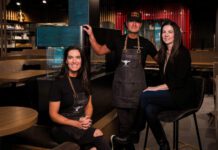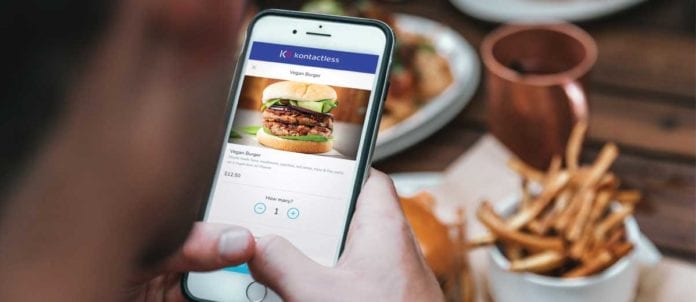Nothing has been easy for foodservice operators in recent months. But one thing helping ease some of the operational headaches has been the role technology innovation is playing in supporting social distancing and safety measures.
Of course, there are the technologies that are always at the heart of “what’s-new” conversations — the role of AI, facial recognition, digital voice assistants, voice-activated kiosks, digital license-plate readers and app-enabled dispensing machines to name a few.
All of these can, and will, play a role in creating a streamlined, contactless version of foodservice operations in the future. But, for many, these emerging trends are taking a back seat to more pressing infrastructure changes, as operators grapple with changing restrictions and increasingly cautious customers.
Novelty projects, such as Bluetooth-enabled beverage dispensers, are losing ground because they put customers back into a restaurant environment, which simply isn’t possible for many, says Jenny Campion, vice-president, Western Operations for The Fifteen Group in Toronto. “Right now, it’s really about operators being able to capture sales and execute them with less labour and contact.”
With the pandemic, investments in applications such as tabletop tablets or kiosk ordering are being bypassed for more readily available tools — more specifically, customers’ own smartphones, she notes.
“The two key technology areas on everyone’s mind these days are touchless and integration. Right now, these are the biggest pieces. The pandemic has fast-forwarded the development of a lot of systems in this area immensely.”
Until this year, the move to digitizing ordering apps, POS functions, loyalty programs and payment has been showing steady adoption. Many operators had been taking a graduated approach because of the costs involved — until now.
Losing in-restaurant dining has been a major catalyst in all this upheaval, as restaurants have had to rely on takeout and delivery to compensate for lost dine-in revenues. Many are having to pivot to a takeout model for the first time, despite the fact their technology infrastructure wasn’t optimized for the transition.
Seamless POS integration
Fortunately, the industry responded quickly, Campion notes. “POS companies quickly jumped into action integrating online ordering, creating mobile apps and making their websites order friendly. Some were being offered free to clients, which is huge.”
Campion describes the speed of integration as “profound,” particularly on the POS front, for smaller independents. “Providers are making it easy for independent restaurants to have online ordering go straight to their POS system. Because so many consumers were using third-party apps for ordering, it was getting very challenging for restaurants to receive and manage orders. Now it can be seamless.”
SilverWare POS Inc. made the shift to improve that portion of its technology, offering online-ordering integration and support services for free to its customers.
“We had an online-ordering component built in for years, but it was rarely used by traditional restaurants,” says Lucky Thalas, executive vice-president, SilverWare POS Inc. “Suddenly there was a need for that base to deploy it. The upper-tier establishments needed to offer pickup, delivery or online ordering to survive.”
Integration with kitchen-display systems provides an added level of efficiency, whether processing dine-in or takeout orders, Campion says. “It’s becoming popular because it makes the entire process digital, from the front of the house to the kitchen, while also streamlining food prep and production.”
The move to contactless
A built-in benefit that came with the move to POS integration has been contactless capabilities, Thalas says. “Contactless was starting to gain a foothold in restaurants, but it has become more relevant to the guest experience now. We’re seeing a number of mobile enhancements in the areas of QR codes and cashless payment apps, as more operators are leaning toward the concept of a single, contactless platform for even more functions.”
Since March, SilverWare added two new mobile components to its offering: contactless menu browsing and ordering. “We decided to create feature sets that mimic the functions of a server, such as being able to view the menu and read details of individual items, order their meals and identify their table number and seating position. In other words, the functions that are usually managed by the server are now being turned over to the guest.”
Contactless is where everyone is looking to invest if they haven’t already, says Gabriel Weisz, CEO of Kallpod, a Los Angeles-based provider of IoT solutions for the hospitality industry. “The industry has been slow to adopt in this area, but that has accelerated at a very significant pace in recent months. Because restaurants run on incredibly small margins, it’s time for them to re-visit how they can make operations a lot more efficient. Everyone realizes these changes are here to stay and should be investing in the right technology solutions that are hugely important.”
His recent blog on contactless technology notes the widespread adoption of contactless technology lacked a strong catalyst until COVID-19. In it, he cites a recent survey by NACS — a global trade association dedicated to advancing convenience and fuel retailing — that states the percentage of customers who prioritized businesses offering pickup curbside or contactless services more than tripled, jumping from 13 per cent pre-pandemic to 49 per cent today.
Data that matters
Accurate data capture is becoming even more relevant as restaurants are mandated to track the names and contact details of patrons. It’s only one of many areas where reservation systems can help serve as a valuable data source.
Mat Weir, founder of First Table, which launched a year ago in Vancouver, says COVID-19 has driven an increase in demand for reservation systems that can do more than confirm bookings. “They not only provide an easier way to monitor and track who is visiting restaurants, they can now expand into digital-marketing services through their subscriber base, from advertising to running targeted promotions.” Restaurants can also tap into their data-capture capabilities to run email campaigns, loyalty programs and follow-up surveys.
Data capture is a veritable gold mine that is often underutilized by restaurant operations as they scramble to react to the here and now, says Jordan Thaeler, founder of WhatsBusy, a provider of data-science services in Houston, Texas. “Restaurants are often missing out on important customer data they can apply to marketing in the future. They can’t see beyond what’s in front of them.”
The ideal approach is a unified customer-base infrastructure that captures data on multiple fronts, from online-ordering volumes to POS systems to social media. While it seems daunting, small operations can easily access those capabilities through cloud-based POS platforms that will automate the data for them, he says.
“In the last couple of years, we’re seeing more and more cloud-based reporting and full integration with inventory systems, scheduling and POS integration, making them more accessible to small independent restaurateurs,” Campion says. “Inventory forecasting and scheduling in particular are growing by leaps and bounds. There are systems now that are able to understand and break down sales and orders from guests day by day. A couple of years ago there were only a few options. Now there are dozens to choose from.”
As the pandemic runs its course, those with funds to invest will be looking to build integrated capabilities that will serve them today and set them up for future success. Maybe then, they can turn back to the more eye-catching technology bells and whistles that have been set aside for the time being.

















